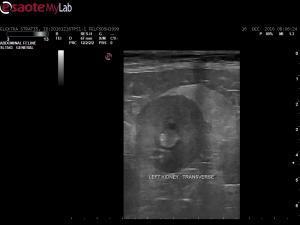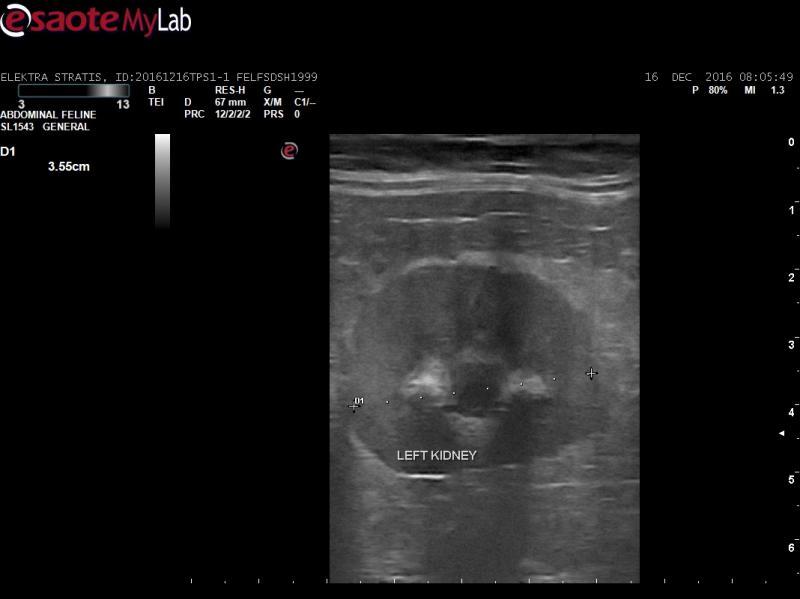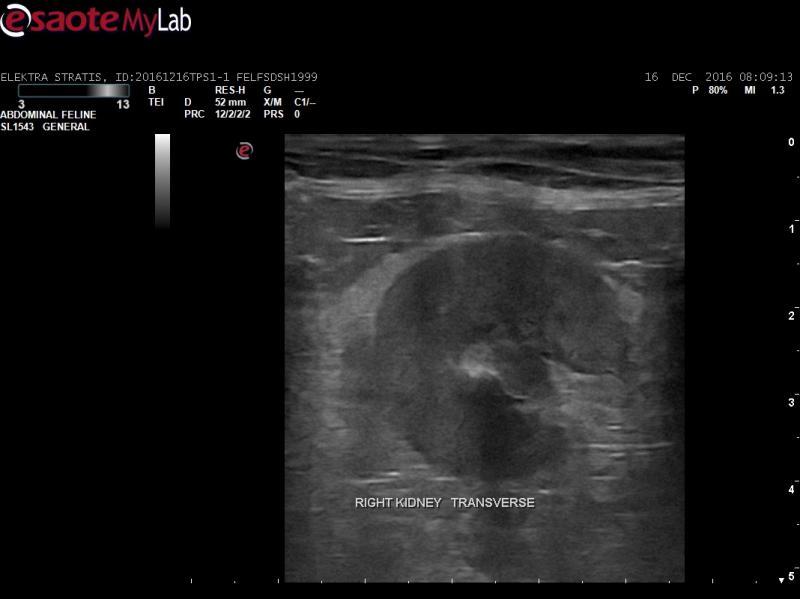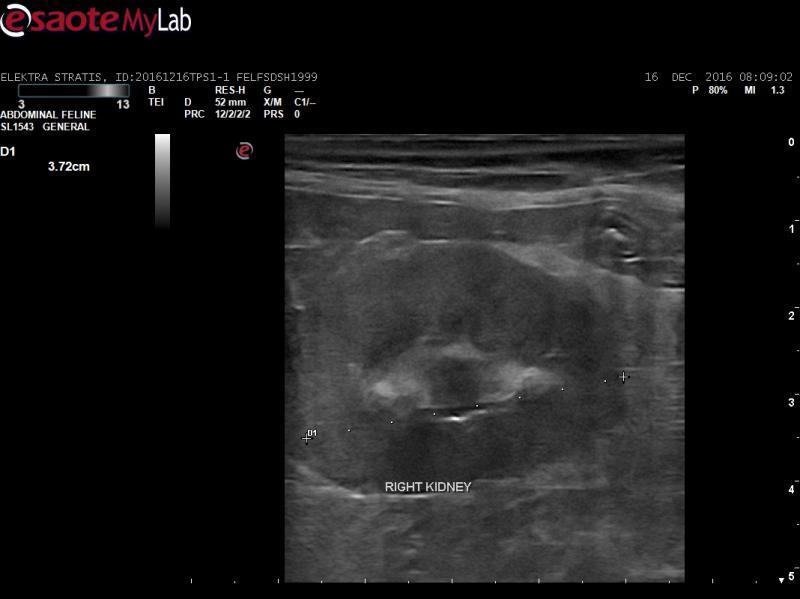Hi everyone,
Just wondering if anyone have diagnosed retoperitonitis in cats via ultrasound? I recently scanned a 16 year old, female spayed DSH who was presented for presumed acute renal failure. She had a dental prophylaxis preformed and pre-anesthetic bloods were unnremarkable. However, cat became ill after surgery and bloods taken showed severe azotaemia. It was suspected the meloxicam given post op caused it? Cat is very painful when palating the abdomen.
Hi everyone,
Just wondering if anyone have diagnosed retoperitonitis in cats via ultrasound? I recently scanned a 16 year old, female spayed DSH who was presented for presumed acute renal failure. She had a dental prophylaxis preformed and pre-anesthetic bloods were unnremarkable. However, cat became ill after surgery and bloods taken showed severe azotaemia. It was suspected the meloxicam given post op caused it? Cat is very painful when palating the abdomen.
The ultrasound performed showed hypoechoic renal cortices with hyperechoic retroperitoneal fat. The cortico-medullary definition was also reduced.
I was reading about idiopathic retroperitonitis fibrosis in humans. Does that happen in cats? Or is this just a case of acute renal failure? Why would the retroperitoneal fat be inflammed?




Comments
Great question!
Great question! Retroperitonitis deriving from nephritis. Any time an organ has aggressive pathology that expands on the capsule the capsule stretches and there is ill defined echogenic fat attached to the serosa as th ebody’s immune resonse to the chematactic event… LSA does this with LN or intestine spleen liver wherever but also aggressive inflammatory disease. Transmural disease is what I call it and for me is always need for a needle … 25 g fna in the renal cortex is what I would do here. Thromboembolic shower will do this in kidneys as well as anything causing acute nephritis, pyelonephritis when bad enough and lsa or fip. The cm junction and pelvises are not distorted so i would downplay neoplasia but TED shower, acute nephritis would be my guess here and fna would help define the inflammation.
Thanks Eric!
Cat is really
Thanks Eric!
Cat is really painful when palpating the kidneys. I wouldn’t be doing a FNA without some sort of sedation? what is safe to use without further damaging the kidneys?
Very irregular capsules here?
Very irregular capsules here? I would also confirm the amount of Metacam given.
Has anyone used metacam in cats on a long term basis. I recently had a cat in from another clinic that was using the oral form on a regular basis. This cat was only getting 0.15 ml of the 0.5 mg/ml oral liquid. Maybe with caution we can use NSAIDS more often in cats if we are careful. I know in other countries they use Metacam for longer periods of time. This seems to hold true for meds that I was tought (a very long time ago) not to use in cats.
Hi Randy,
The cat was given
Hi Randy,
The cat was given a subcutaneous dose of 0.3ml. Cat weighs 4.5kg.
I have dispensed long term oral meloxicam at a dosage of 0.03mg/kg/day, usually due to really bad osteoarthritis. I havent had trouble in any of my patients.
as I understand its
as I understand its contraindicated when dehydration is present though and I think a lot of people forget about that…
The capsules in the images are not so much irregular as there is the hyperechoic inflammatory pattern associated with the capsules.
There have been some long
There have been some long term term studies in cats with CKD and use of meloxicam, without any apparent adverse effects:
Gowan RA, Lingard AE, Johnston L, Stansen W, Brown SA, Malik R. Retrospective case-control study of the effects of long-term dosing with meloxicam on renal function in aged cats with degenerative joint disease. J Feline Med Surg. 2011, 13:752-61.
Medical records (2005-2009) of a feline-only practice were searched for cats with degenerative joint disease (DJD) treated using meloxicam. DJD was diagnosed by the presence of at least two of the following: (i) altered mobility (observed by the owner), (ii) abnormal physical findings, (iii) characteristic radiographic changes. The primary study cohort consisted of cats older than 7 years that had received meloxicam for variable intervals in excess of 6 months, and for which complete records were available. These cats were subdivided according to whether detectable chronic kidney disease (CKD) was present (‘renal group’), or not (‘non-renal group’), and, for the ‘renal group’, according to the cat’s IRIS category. Serum biochemistry, urinalysis (including urine specific gravity [USG]), body mass and condition score were monitored regularly. Progression of CKD in the ‘renal group’ and ‘non-renal group’ of cats was compared to two groups of age- and IRIS-matched control cats not receiving meloxicam (from the same clinic, over the same time period). The study was thus a case-control design, with two study groups. Thirty-eight cats with DJD receiving long-term meloxicam therapy met the inclusion criteria. Of these, 22 cats had stable CKD at the start of treatment (stage 1, eight cats; stage 2, 13 cats; stage 3, one cat). No cats initially had an elevated urinary protein to creatinine ratio. The remaining 16 cats initially had normal renal analytes and adequately concentrated urine. The median age of the ‘renal’ and ‘non-renal’ meloxicam groups was 15.5 and 13.4 years, respectively. The median treatment duration was 467 days in the ‘renal group’ and 327 days in the ‘non-renal group’. After titration (to the lowest effective dose), the median maintenance dose was 0.02 mg/kg/day in both groups (range 0.015-0.033 mg/kg/day). There was no difference in sequential serum creatinine concentration or USG measurements between the ‘non-renal group’ treated with meloxicam compared to control cats not treated with meloxicam. There was less progression of renal disease in the ‘renal group’ treated with meloxicam compared to the age- and IRIS-matched cats with CKD not given meloxicam. These results suggest that a long-term maintenance dose of 0.02 mg/kg of meloxicam can be safely administered to cats older than 7 years even if they have CKD, provided their overall clinical status is stable. Long-term meloxicam therapy may slow the progression of renal disease in some cats suffering from both CKD and DJD. Prospective studies are required to confirm these findings.
Gowan RA, Baral RM, Lingard AE, Catt MJ, Stansen W, Johnston L, Malik R. A retrospective analysis of the effects of meloxicam on the longevity of aged cats with and without overt chronic kidney disease. J Feline Med Surg. 2012, 14:876-81.
The study sought to examine the effect of long-term meloxicam treatment on the survival of cats with and without naturally-occurring chronic kidney disease at the initiation of therapy. The databases of two feline-only clinics were searched for cats older than 7 years that had been treated continuously with meloxicam for a period of longer than 6 months. Only cats with complete medical records available for review were recruited into the study. The median longevity in the renal group was 18.6 years [95% confidence interval (CI) 17.5-19.2] and the non-renal group was 22 years [95% CI 18.5-23.8]. The median longevity after diagnosis of CKD was 1608 days [95% confidence interval 1344-1919], which compares favourably to previously published survival times of cats with CKD. In both groups the most common cause of death was neoplasia. Long-term treatment with oral meloxicam did not appear to reduce the lifespan of cats with pre-existent stable CKD, even for cats in IRIS stages II and III. Therefore, to address the need for both quality of life and longevity in cats with chronic painful conditions, meloxicam should be considered as a part of the therapeutic regimen.